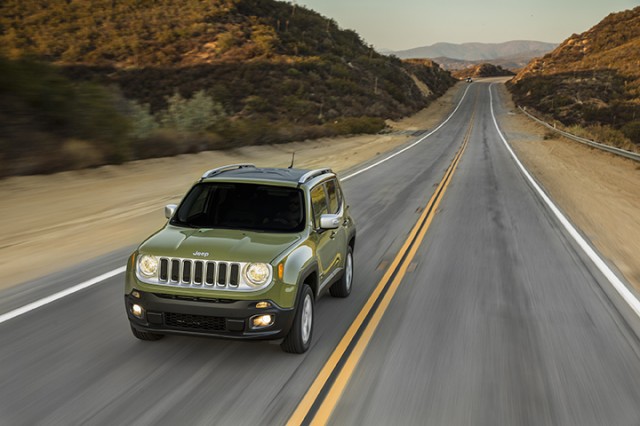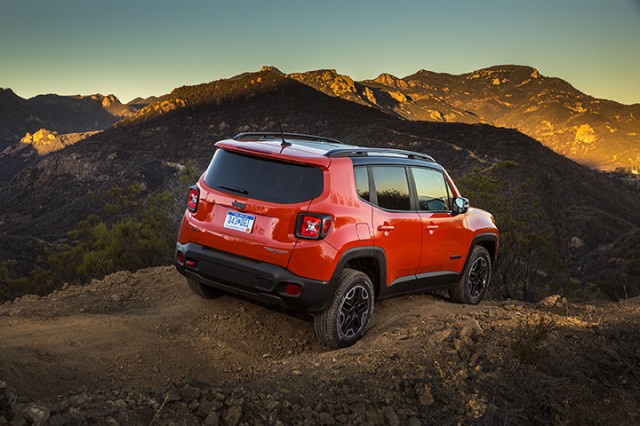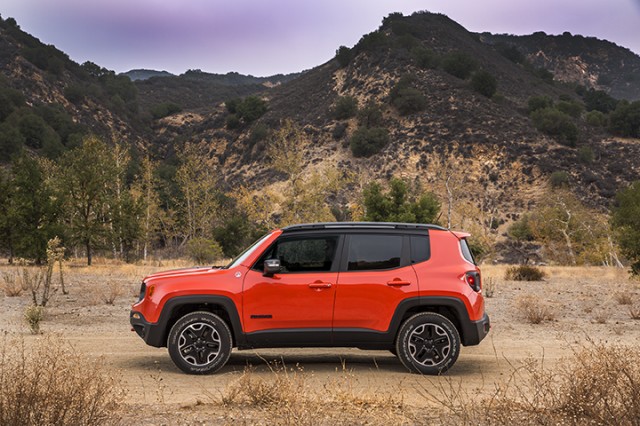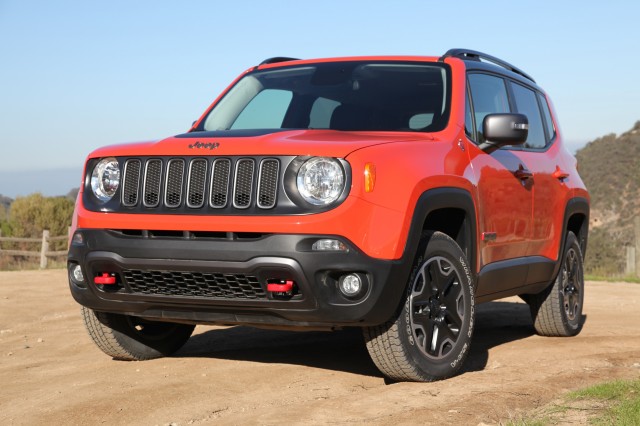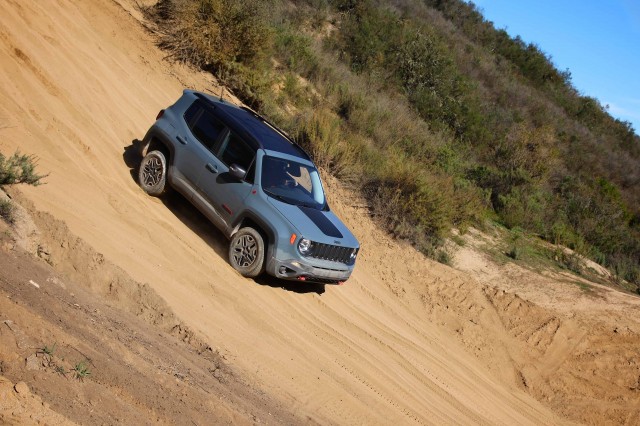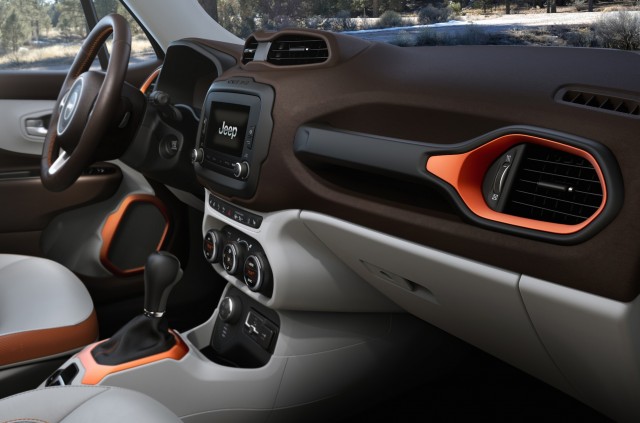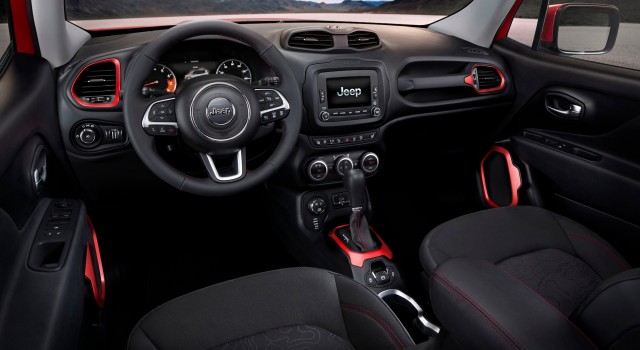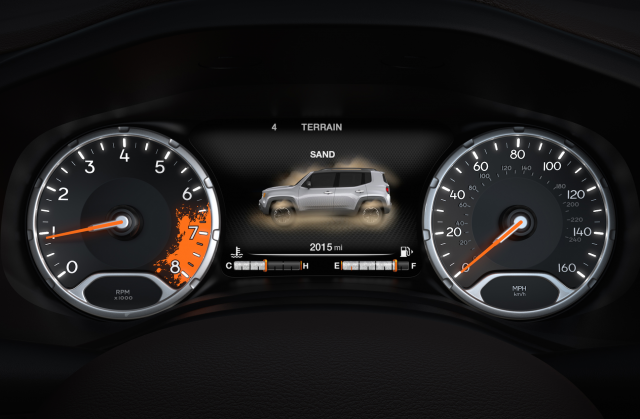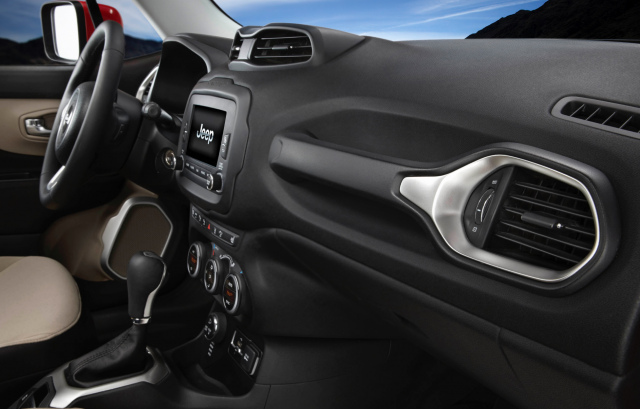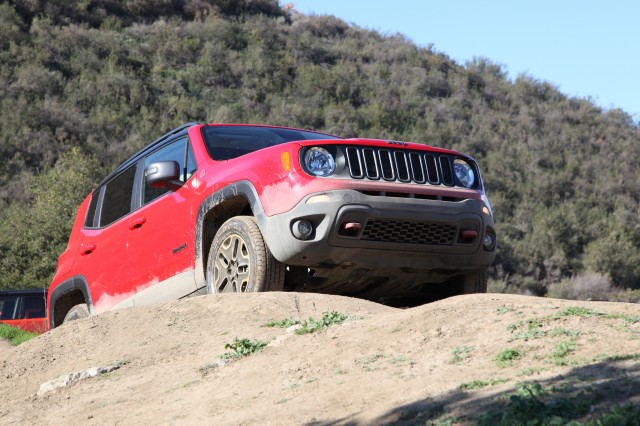Two years ago when Jeep launched their new Cherokee, you could almost hear the collective groan from around the globe. Many Jeep loyalists were quick to lambast the new vehicle with its slanted nose and squinty headlights, going so far as to chide Jeep for “ruining the brand.” If you were amidst those voices claiming the Cherokee sounded the death knell for Jeep, you were––wrong. Love it or loathe it, the sale of more than a quarter of a million new Cherokees has qualified it as a whopper of a success story, and we’re not even to the next chapter.
That next chapter belongs to the Renegade, another vehicle seemingly purpose built to antagonize the legions of loyalists who think Jeep’s best work begins and ends with the Wrangler. That platform is without question the hallmark of Jeep, the automotive DNA that the designers strive to infuse into every platform big or small. And speaking of small, if you haven’t noticed, downsizing is the latest craze in everything from houses to, well, SUVs. This is a space Jeep needed to enter.
The design mission of the Renegade is simple enough: To provide the small SUV category (globally) with a vehicle engineered to compete with existing models, but also to clobber the competition off-road. Keep in mind, that competition consists of mainly tarmac-biased vehicles like the Nissan Juke, Kia Soul, Mini Countryman, and the Buick Encore. These are not exactly titans of the backwood, although the Subaru Crosstrek has admirable dirt aptitude.
It’s understandable why Jeep wanted to throw their hat in this ring, but we wanted to know how well they did with their little 4×4, so we spent a couple days behind the wheel. Before I proffer my humble assessment, let’s take a walk through the vehicle details.
Available to the North American market in Sport, Latitude, Limited, and Trailhawk trim levels, the Renegade is also offered in both 4×4 and 4×2 drivetrains with the off-road inspired Trailhawk only available as a 4×4. There are two engine choices, and an available 6-speed manual transmission, although only on select models. Towing capacity is rated to 2,000 pounds.
Engines and Transmissions
The base engine is Fiat’s turbocharged 1.4-liter Multi-Air four-cylinder which produces 160 horse power and 184 foot-pounds of torque. That engine is paired exclusively to the 6-speed manual gearbox. The larger 2.4-liter naturally aspirated four-cylinder Tigershark engine generates 180 horses and 193 foot-pounds of torque. The Tigershark power plant is paired to Fiat-Chrysler’s nine-speed automatic changer. Although definitive numbers are forthcoming, Jeep claims both engines will achieve better than 30 mpg numbers, and given our two days at the wheel, appears to be right on target.
Trim Levels
The Sport, Latitude and Limited models all share similar fascia, the off-road objective slightly detuned from the Trailhawk. The most noticeable difference with the Trailhawk is its unique front and rear bumper treatments designed to give optimal approach and departure angles. The Limited, pictured above, is the more luxuriously appointed trim level with more brightwork at the grill, mirrors and wheels. The Trailhawk features more black-out elements. The Latitude straddles the extremes of the Sport and Trailhawk and will likely prove to be the primary hot seller.
Trailhawk Off-Road Package
Like the Cherokee Trailhawk, the Renegade’s off-road model has a host of features aimed directly at the off-road enthusiast, even in such a diminutive platform. The 30.5 degree approach angle paired to the 34.3 degree departure angle are unrivaled by anything in the small SUV segment and best many of the auto industry’s off-road inspired vehicles. The 19-inch water fording depth is also a class leader. The 8.7-inches of ground clearance is only matched by the Subaru Crosstrek, and while articulation is clearly limited, suspension travel is a respectable 8.1-inches.
The Trailhawk Renegade also feature’s Jeep’s Selec-Terrain system with settings for: Auto, Snow, Sand, Mud, and Rock. The 4-Low mode, available only on the Trailhawk, provides a 20:1 crawl ratio, again something not offered anywhere else in the small SUV market. Other off-road inspired features include full strength tow hooks front and rear as well as skid-plates in critical areas. The Hill-Descent Control feature, something oft under-used, is poised and effective, not displaying the jerkiness that afflicts other systems.
Features and options
In an effort to deliver on the authenticity of the Jeep experience, the designers wanted to offer drivers the open-air feel of the Wrangler. The Renegade’s MySky roof system consists of two panels which can be opened to reveal two large roof apertures for a near-convertable feel. The upper end MySky system includes an electronically retracted front panel. When fully removed, both MySky panels fit in a dedicated soft case in the cargo area and consume considerably small storage space. There’s even WiFi availability to make optimal use of Jeep’s Uconnect system for wireless calls and information access.
Interior appointments
Slipping into the Limited Renegade wrapped in leather and festooned with high quality materials, it is impossible not to commend Jeep’s designers for a job well done. Available with heated seats and wheel, as well as advanced technologies like lane assist and sat-nav, the Renegade is extremely comfortable. Interior room is surprisingly generous with good visibility at all corners. The instrument cluster features a full-color 7-inch display, and all of the vents and controls feel properly placed and solid. The use of hard and soft touch materials adds nice contrast with the faux-anodized accents bolstering the aesthetic refinements.
Pricing
With a base price of just $17,999, the Sport will draw in many first-time new car buyers, but it is the 4×4 Latitude at $23,295 that will likely be the strong mover. The luxuriously appointed Limited starts at $26,795 although the fully loaded Limited I tested with all the bells and whistles clocked in at over $33,000. The Trailhawk, only available in 4×4, starts at $25,995 but again, the model I tested was considerably more at over $32,000 with considerable options added to the ticket.
First Drive Impressions
On the road: In the two-hour drive to the off-road course by way of serpentine mountain roads, the 1.4-liter turbocharged Renegade with the 6-speed manual gearbox proved to be extremely fun and sporty to drive. Body roll was modestly noticeable, but the car was confidently planted, even as the tires howled. The manual changer is the same used in the Dodge Dart, but according to the engineers, was improved specifically for the Renegade to offer smoother transitions. The clutch has a nice fluid feel with good feedback, a comfortable throw, and worked well off-road. Road noise was minimal, and thanks to the Koni Frequency Selective Damping front and rear struts, was compliant but firm when necessary. The Renegade surprised almost everyone in the press corps with it’s nimble and comfortable road manners. It’s no Grand Cherokee, but then again, it doesn’t aspire to be.
Off-road: With dozens of journalists all taking laps around the off-road course in the California hills, few if any, returned unimpressed by the Renegade Trailhawk’s off-road prowess. Easy to drive, even with one or two wheels wagging in the air, the Trailhawk bested terrain that at first blush seemed like JK turf. The wide stance, short wheelbase, and very adept traction control system made short work of modest obstacles. If you’re a Renegade skeptic, and I wouldn’t fault you for being one, nothing I report here will likely convince you that this little off-roader is as good as it is. But, just know that nearly everyone that got behind the wheel was stunned by how well it did in the dirt.
Of Lifts and Mods
This being Expedition Portal, invariably someone is going to chime in and ask about fitting the Renegade with a lift and a set of giant meats. This is not a mod-mobile. That’s JK space. The designers did their best to achieve the upper end of the Renegade’s off-road performance, the Trailhawk getting a 1” lift and optimized fascia. While there was talk of potential lift options, they’d be modest at most. If you seek more off-road aptitude than can be provided by the Renegade, you should ideally look to other platforms like the Grand Cherokee, or just cut to the chase and buy a JK.
The final verdict
There’s much to like about the Renegade––if you accept it for what it is. It handles well on the road, does even better off-road, all while sipping fuel and providing a fun and comfortable driving experience. The pricing is competitive and the styling is arguably less controversial than that of the Cherokee. In an effort to make the Renegade undeniably Jeep-ish, they may have gone overboard with the branding. The interior is littered with logos and call-outs to remind drivers they are in a Jeep.
Two things about the Renegade seem inevitable. First, it will undoubtably be a global success. Secondly, ardent fans of the Wrangler and its storied legacy will recoil every time they see a Renegade on the road, or worse, on the trail. However, taken for what is and the niche it’s supposed to serve, it’s a great little rig.




